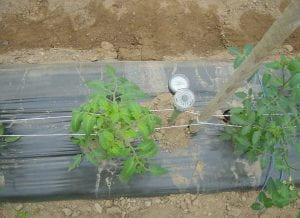Rose Ogutu, Horticulture Specialist, Delaware State University rogutu@desu.edu
A uniformly moist soil is ideal for most horticultural crop production, yet high tunnels receive no external rainfall. It is important to maintain adequate soil water content during pollination and fruit development right up to harvest. Most irrigated vegetable crops develop shallow roots with no more than 10 to 12 inches of rooting depth (onions develop about 6 inches). This depth is achieved within 30 to 40 days from planting. Extreme fluctuations of wet and dry conditions cause yield loss and reduce quality of produce. Overwatering produces much shallower than anticipated rooting depth, and encourages N-leaching from the root zone and can result into root rots and slow growth. The high humidity caused by the free water and high temperatures also enhance disease incidence. Incidences of blossom-end-rot and cracking of tomatoes can be a result of overwatering. It is important to always refill the soil profile at every irrigation event. Frequent light watering causes shallow root systems.
Drip irrigation is the most effective watering system in plasticulture production as it helps maintain uniform soil moisture.
 Water distribution from drip tape between rows of lettuce
Water distribution from drip tape between rows of lettuce
A full season crop like tomatoes or cucumbers may require 14 to 20 inches of soil water to meet the crop’s daily evapotranspiration (ET) throughout the growing season (1 inch of soil water from a 100-foot row with an average canopy of 18 inches = 94 gallons or for 24 inches = 125 gallons). Soil water can be extracted by a plant and evaporated at a rate of 0.05 to over 0.30 inches per day, depending on the stage of plant growth, tunnel temperature and amount of sunshine (equivalent to approximately 5 to 50 gallons per day per 100 ft of plant row dependent on plant width).
To adequately plan your irrigation system:
● Evaluate the crops water needs, water use at peak periods, fertility needs, soil type, plant row layout and water supply.
● Ensure adequate drainage of your soil. If possible, keep organic matter at 5 to 6 percent.
● Make sure you have an adequate water supply. A typical drip system for a 30 x 96 ft high tunnel may need a water supply pumping rate of 2.5 to 4 gallons/minute of the selected drip tubing. For multiple tunnel units, a larger well and dedicated pump may be required. Sources from lake or stream may require more filtration to prevent the drip irrigation system from plugging. The main line from the water source should be sized to provide adequate pressure and flow rate. For a single high tunnel unit, a ¾ to 1 inch pipe should be adequate to deliver 3 to 4 gpm at an operating pressure within 30 to 40 psi so that one can easily operate a fertigation system along with the drip system.
● Choose the right drip tubing to ensure uniform delivery. Drip tubing comes in various wall thicknesses (4 mils to over 15 mils). Thinner tubing types (4 to 10 mils) are commonly used in mulch row beds found in high tunnel systems. Emitter spacing of 8 to 12 inches deliver uniform and continuous wetting patterns along the plant row to give 0.2 to 0.6 gallons/min per 100 feet tubing. Tubing emitters should always be placed facing upwards and placed in shallow groove. For single row plants (e.g. tomatoes and cucumbers), place drip tape in the center or 4 to 5 inches from the center of the bed. For double row crops (e.g. pepper, egg plants, strawberries), a single irrigation tube in the center, slightly buried should be adequate.
● When placing different plants on the same row consider their watering needs.
● Use soil moisture sensors and establish a schedule for reading them. Work the tensiometers at different depths based on soil type. A soil feel damp/moist method can help, and for a silt loam soil can be fairly accurate.
● Examine the root development of several plants 40 to 50 days after planting to observe how they interact with the soil profile and the irrigation zone.
For more information on water management in high tunnels refer to: http://www.extension.umn.edu/distribution/horticulture/components/m1218-7.pdf
 A tensiometer at a correct depth will help guide watering needs.
A tensiometer at a correct depth will help guide watering needs.
